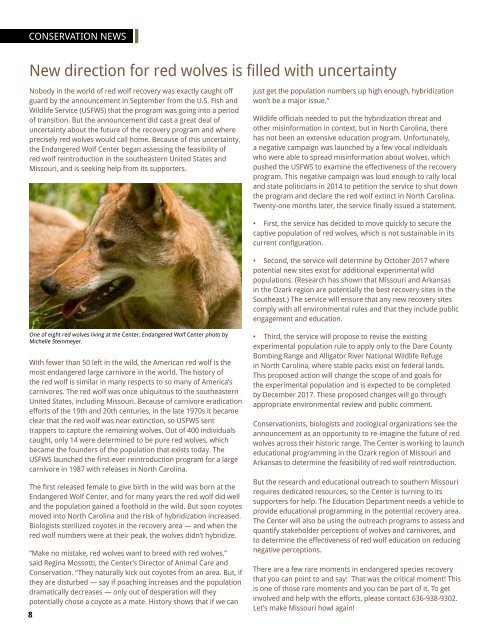Winter 2016
Winter2016Magazine
Winter2016Magazine
You also want an ePaper? Increase the reach of your titles
YUMPU automatically turns print PDFs into web optimized ePapers that Google loves.
CONSERVATION NEWS<br />
New direction for red wolves is filled with uncertainty<br />
Nobody in the world of red wolf recovery was exactly caught off<br />
guard by the announcement in September from the U.S. Fish and<br />
Wildlife Service (USFWS) that the program was going into a period<br />
of transition. But the announcement did cast a great deal of<br />
uncertainty about the future of the recovery program and where<br />
precisely red wolves would call home. Because of this uncertainty,<br />
the Endangered Wolf Center began assessing the feasibility of<br />
red wolf reintroduction in the southeastern United States and<br />
Missouri, and is seeking help from its supporters.<br />
just get the population numbers up high enough, hybridization<br />
won’t be a major issue.”<br />
Wildlife officials needed to put the hybridization threat and<br />
other misinformation in context, but in North Carolina, there<br />
has not been an extensive education program. Unfortunately,<br />
a negative campaign was launched by a few vocal individuals<br />
who were able to spread misinformation about wolves, which<br />
pushed the USFWS to examine the effectiveness of the recovery<br />
program. This negative campaign was loud enough to rally local<br />
and state politicians in 2014 to petition the service to shut down<br />
the program and declare the red wolf extinct in North Carolina.<br />
Twenty-one months later, the service finally issued a statement.<br />
• First, the service has decided to move quickly to secure the<br />
captive population of red wolves, which is not sustainable in its<br />
current configuration.<br />
• Second, the service will determine by October 2017 where<br />
potential new sites exist for additional experimental wild<br />
populations. (Research has shown that Missouri and Arkansas<br />
in the Ozark region are potentially the best recovery sites in the<br />
Southeast.) The service will ensure that any new recovery sites<br />
comply with all environmental rules and that they include public<br />
engagement and education.<br />
One of eight red wolves living at the Center. Endangered Wolf Center photo by<br />
Michelle Steinmeyer.<br />
With fewer than 50 left in the wild, the American red wolf is the<br />
most endangered large carnivore in the world. The history of<br />
the red wolf is similar in many respects to so many of America’s<br />
carnivores. The red wolf was once ubiquitous to the southeastern<br />
United States, including Missouri. Because of carnivore eradication<br />
efforts of the 19th and 20th centuries, in the late 1970s it became<br />
clear that the red wolf was near extinction, so USFWS sent<br />
trappers to capture the remaining wolves. Out of 400 individuals<br />
caught, only 14 were determined to be pure red wolves, which<br />
became the founders of the population that exists today. The<br />
USFWS launched the first-ever reintroduction program for a large<br />
carnivore in 1987 with releases in North Carolina.<br />
The first released female to give birth in the wild was born at the<br />
Endangered Wolf Center, and for many years the red wolf did well<br />
and the population gained a foothold in the wild. But soon coyotes<br />
moved into North Carolina and the risk of hybridization increased.<br />
Biologists sterilized coyotes in the recovery area — and when the<br />
red wolf numbers were at their peak, the wolves didn’t hybridize.<br />
“Make no mistake, red wolves want to breed with red wolves,”<br />
said Regina Mossotti, the Center’s Director of Animal Care and<br />
Conservation. “They naturally kick out coyotes from an area. But, if<br />
they are disturbed — say if poaching increases and the population<br />
dramatically decreases — only out of desperation will they<br />
potentially chose a coyote as a mate. History shows that if we can<br />
8<br />
• Third, the service will propose to revise the existing<br />
experimental population rule to apply only to the Dare County<br />
Bombing Range and Alligator River National Wildlife Refuge<br />
in North Carolina, where stable packs exist on federal lands.<br />
This proposed action will change the scope of and goals for<br />
the experimental population and is expected to be completed<br />
by December 2017. These proposed changes will go through<br />
appropriate environmental review and public comment.<br />
Conservationists, biologists and zoological organizations see the<br />
announcement as an opportunity to re-imagine the future of red<br />
wolves across their historic range. The Center is working to launch<br />
educational programming in the Ozark region of Missouri and<br />
Arkansas to determine the feasibility of red wolf reintroduction.<br />
But the research and educational outreach to southern Missouri<br />
requires dedicated resources, so the Center is turning to its<br />
supporters for help. The Education Department needs a vehicle to<br />
provide educational programming in the potential recovery area.<br />
The Center will also be using the outreach programs to assess and<br />
quantify stakeholder perceptions of wolves and carnivores, and<br />
to determine the effectiveness of red wolf education on reducing<br />
negative perceptions.<br />
There are a few rare moments in endangered species recovery<br />
that you can point to and say: That was the critical moment! This<br />
is one of those rare moments and you can be part of it. To get<br />
involved and help with the efforts, please contact 636-938-9302.<br />
Let’s make Missouri howl again!


